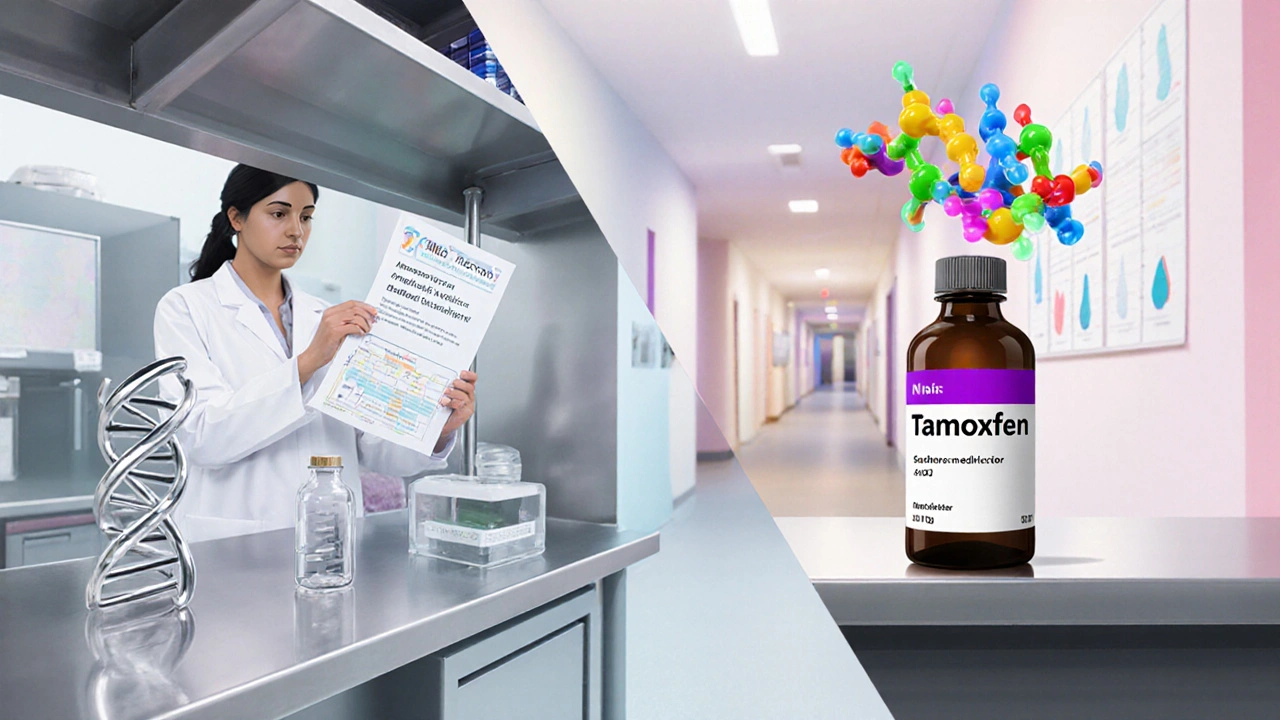ER+ Breast Cancer Hormonal Therapy Selector
Select your condition to get personalized recommendations:
Nolvadex (Tamoxifen) is a selective estrogen receptor modulator (SERM) approved in 1977 for treating estrogen receptor‑positive (ER+) breast cancer. It works by blocking estrogen from binding to its receptor in breast tissue while acting like estrogen in bone and the uterus. That dual‑action makes it a cornerstone of adjuvant therapy, especially for pre‑menopausal patients.
Why Tamoxifen Still Matters
More than four decades of data show that a five‑year course of Tamoxifen cuts recurrence risk by roughly 40% in early‑stage ER+ disease. The drug’s oral dosing (20mg daily) and low cost keep it popular worldwide. Its active metabolite, endoxifen, is generated by the liver enzyme CYP2D6, which means patients with poor‑function CYP2D6 alleles may see reduced benefit.
Key Pharmacologic Attributes
- Bioavailability: ~70% after oral intake.
- Half‑life: 5‑7 days for parent drug, 14 days for endoxifen.
- Metabolism: Primarily via CYP2D6 and CYP3A4.
- Typical side‑effects: Hot flashes, menstrual irregularities, deep‑vein thrombosis (DVT), and a modest increase in endometrial cancer risk.
Big‑Picture Alternatives
When clinicians talk about "alternatives," they’re usually referring to other endocrine agents that either lower estrogen levels (aromatase inhibitors) or degrade the estrogen receptor (SERDs). Below is a quick snapshot of the most common options.
| Agent | Mechanism | Typical Use (Adjuvant) | FDA Approval Year | Key Side‑effects |
|---|---|---|---|---|
| Tamoxifen | SERM - blocks ER in breast, agonist in bone/uterus | Premenopausal & postmenopausal (5‑yr) | 1977 | Hot flashes, DVT, endometrial cancer |
| Anastrozole | Non‑steroidal aromatase inhibitor | Postmenopausal (5‑yr) | 1995 | Joint pain, osteoporosis, hypercholesterolemia |
| Letrozole | Non‑steroidal aromatase inhibitor | Postmenopausal (5‑yr or extended) | 1997 | Arthralgia, bone loss, fatigue |
| Exemestane | Irreversible steroidal aromatase inhibitor | Postmenopausal (after 2‑yr Tamoxifen) | 1999 | Hot flashes, decreased bone density |
| Raloxifene | SERM - bone agonist, breast antagonist | Osteoporosis; limited breast cancer use | 1998 | Leg cramps, DVT, mild hot flashes |
| Fulvestrant | SERD - degrades ER | Metastatic ER+ disease (injectable) | 2002 | Injection site pain, nausea, liver enzyme rise |
When to Pick an Aromatase Inhibitor Over Tamoxifen
Aromatase inhibitors (AIs) such as Anastrozole, Letrozole and Exemestane are preferred for post‑menopausal women because they cut estrogen production at the source. Clinical trials (e.g., ATAC, BIG1‑98) consistently showed a 3‑5% absolute improvement in disease‑free survival compared with five years of Tamoxifen.
However, AI‑related bone loss can be a deal‑breaker for patients with existing osteoporosis. In those cases, adding a bisphosphonate or switching to a SERM with bone‑protective properties-like Raloxifene-might be safer.

Choosing Tamoxifen for Premenopausal Patients
Premenopausal patients still produce ovarian estrogen, so AIs alone are ineffective unless ovarian function is medically suppressed (e.g., GnRH agonists). Tamoxifen’s ability to block estrogen receptors directly makes it the first‑line option. Recent data from the SOFT and TEXT trials suggest that adding ovarian suppression to Tamoxifen (or an AI) reduces recurrence further, but the addition also brings extra side‑effects like amenorrhea and bone loss.
Genetic Considerations: CYP2D6 Polymorphisms
The enzyme CYP2D6 converts Tamoxifen into its potent metabolite endoxifen. Patients carrying two non‑functional alleles (poor metabolizers) can see up to a 30% drop in endoxifen levels, correlating with slightly higher recurrence rates. In practice, many oncologists order a CYP2D6 genotype test when planning long‑term Tamoxifen. If a patient is a poor metabolizer, switching to an AI (if post‑menopausal) or using a higher Tamoxifen dose (though evidence is mixed) are typical strategies.
Side‑Effect Profiles at a Glance
Understanding the side‑effect landscape is key to adherence. Below is a concise look at what patients usually experience:
- Hot flashes: Common to Tamoxifen, AIs, and GnRH agonists; usually managed with lifestyle changes or low‑dose SSRIs.
- Thromboembolic events: More frequent with Tamoxifen and Raloxifene; rare with AIs.
- Bone health: AIs accelerate bone loss; Tamoxifen and Raloxifene can protect bone density.
- Endometrial effects: Tamoxifen slightly raises uterine cancer risk; AIs do not.
Practical Tips for Real‑World Use
- Confirm menopausal status before picking an AI. If uncertain, check FSH/LH levels.
- Order a CYP2D6 test if planning a 5‑year Tamoxifen course.
- Schedule a baseline DEXA scan. If bone density is low, consider adding a bisphosphonate or choosing a bone‑friendly SERM.
- Educate patients about the time‑lag for side‑effects. Most hot flashes peak in the first 6 months and often improve.
- Monitor liver enzymes every 3‑6 months for patients on Fulvestrant or high‑dose Tamoxifen.
Related Concepts and Next Steps
The discussion of Estrogen receptor positive breast cancer sits inside a larger knowledge cluster that includes hormone therapy, tumor genetics (e.g., HER2 status), and survivorship care. If you’ve finished reading about Tamoxifen alternatives, you might explore:
- “Extended endocrine therapy beyond five years” - what the latest trials say.
- “Managing AI‑induced osteoporosis” - lifestyle and pharmacologic options.
- “New SERDs in development” - next‑generation drugs aiming to replace Fulvestrant.

Frequently Asked Questions
Is Tamoxifen still the best choice for pre‑menopausal women?
Yes, for most pre‑menopausal patients Tamoxifen remains first‑line because AIs need ovarian suppression to work. Recent trials show adding GnRH agonists to Tamoxifen can improve outcomes, but the combination also raises side‑effects. Decision should balance recurrence risk, fertility wishes, and tolerance of hot flashes or bone loss.
Can I switch from Tamoxifen to an aromatase inhibitor after two years?
Switching after 2‑3years is a common strategy, especially for post‑menopausal women or those who become post‑menopausal during treatment. The ATLAS and aTTom trials support extended therapy, and a “switch” approach can reduce side‑effects such as endometrial risk while maintaining efficacy.
What does a poor CYP2D6 genotype mean for my Tamoxifen therapy?
A poor metabolizer may not convert enough Tamoxifen into endoxifen, potentially lowering its anti‑cancer effect. In practice, doctors may either switch the patient to an AI (if post‑menopausal) or consider a higher Tamoxifen dose, though higher dosing hasn't consistently shown better outcomes. Genetic testing helps personalize the plan.
Why do aromatase inhibitors cause more joint pain than Tamoxifen?
AIs sharply lower circulating estrogen, which influences pain perception and joint lubrication. The resulting arthralgia-often called “AI‑induced arthropathy”-affects up to 20% of patients. Simple measures like low‑impact exercise, NSAIDs, or switching to a different AI can help.
Is Raloxifene a viable alternative for breast cancer prevention?
Raloxifene is approved for osteoporosis and has modest breast‑cancer‑risk reduction in high‑risk post‑menopausal women, but it’s less effective than Tamoxifen in preventing invasive disease. It does have a lower risk of DVT and no endometrial cancer risk, making it an option for women who can’t tolerate Tamoxifen.


Xing yu Tao
September 26, 2025
In the realm of estrogen‑receptor‑positive breast cancer, the decision matrix hinges upon menopausal status, CYP2D6 metabolism, and the nuanced side‑effect profile of each endocrine agent. Tamoxifen, as a selective estrogen receptor modulator, retains its primacy for premenopausal patients precisely because aromatase inhibitors lack efficacy without ovarian suppression. Moreover, the pharmacokinetic attributes-namely a half‑life extending to a week for the parent compound and two weeks for endoxifen-facilitate adherence through once‑daily oral dosing. Nonetheless, clinicians must remain vigilant for thromboembolic phenomena and the modest elevation in endometrial carcinoma risk, particularly in women with prolonged exposure. When a patient is identified as a poor CYP2D6 metabolizer, a judicious alternative is the initiation of an aromatase inhibitor, provided she is post‑menopausal, thereby circumventing insufficient endoxifen formation. It is also prudent to assess baseline bone mineral density before committing to an aromatase inhibitor, given its propensity for accelerated bone loss. In summary, the therapeutic algorithm should be individualized, integrating genetic testing, menopausal confirmation, and comorbidities to optimize outcomes.
Adam Stewart
September 29, 2025
When guiding a patient through endocrine options, it helps to pause and ensure she feels heard; a calm conversation often eases anxiety about side‑effects.
Selena Justin
October 1, 2025
One key point is that hot flashes are common across both tamoxifen and aromatase inhibitors, yet they tend to peak in the first six months and often diminish with time, so setting realistic expectations can improve adherence.
Bernard Lingcod
October 3, 2025
Considering the metabolic pathway, patients with a normal CYP2D6 genotype typically achieve therapeutic endoxifen concentrations, making tamoxifen a reliable first‑line choice unless contraindications arise.
Raghav Suri
October 5, 2025
Look, if you’re post‑menopausal and a poor metabolizer, sticking with tamoxifen is a gamble – switch to an AI like anastrozole and you’ll cut recurrence risk without the endometrial worry.
Freddy Torres
October 7, 2025
Bone‑friendly SERMs are a solid fallback.
Andrew McKinnon
October 9, 2025
Let's cut to the chase: tamoxifen's estrogenic flip‑flop can be a double‑edged sword, delivering bone protection on one side while flirting with uterine hyperplasia on the other-classic pharma ambivalence.
Dean Gill
October 11, 2025
When navigating the maze of hormonal therapies for ER‑positive breast cancer, the first checkpoint is always the patient’s menopausal status, because that single factor dictates whether the estrogen synthesis pathway is still active in the ovaries or has shifted predominantly to peripheral conversion, which in turn determines the suitability of aromatase inhibition versus estrogen receptor blockade.
For pre‑menopausal women, the ovaries continue to pump out estrogen, rendering aromatase inhibitors ineffective unless you add a GnRH agonist to suppress ovarian function, a strategy that introduces its own set of side‑effects such as hot flashes, mood swings, and potential bone loss, thereby complicating the therapeutic landscape.
Tamoxifen, by directly antagonizing the estrogen receptor in breast tissue while agonizing bone and uterus, remains the cornerstone for this group, especially given its decades‑long track record of reducing recurrence by roughly 40% when taken for five years.
However, one must not overlook the risk of venous thromboembolism and a modest increase in endometrial cancer, which necessitates periodic gynecologic surveillance.
For post‑menopausal patients, the equation changes dramatically; peripheral aromatization of androgens becomes the primary source of estrogen, so aromatase inhibitors such as anastrozole, letrozole, or exemestane can suppress estrogen levels more profoundly than tamoxifen, translating into a 3‑5% absolute improvement in disease‑free survival in large trials like ATAC and BIG 1‑98.
These agents, however, are notorious for accelerating bone loss, so a baseline DEXA scan and consideration of bisphosphonate therapy are advisable, particularly in women with osteopenia or osteoporosis.
In addition, the CYP2D6 genotype adds another layer of personalization: poor metabolizers may generate insufficient endoxifen from tamoxifen, diminishing its efficacy, which makes an aromatase inhibitor the logical alternative for post‑menopausal patients who carry two non‑functional alleles.
Conversely, if a post‑menopausal patient is a normal metabolizer and tolerates tamoxifen well, the decision may hinge on personal preference regarding side‑effect profiles, such as preferring the joint aches of AI versus the hot‑flash and thrombosis risk of tamoxifen.
Extended therapy beyond five years, either with continued AI or switch‑over strategies, has shown additional benefit in the ATLAS and aTTom trials, especially in patients with higher risk features.
Throughout this decision‑making process, shared decision‑making is paramount: discuss the trade‑offs, monitor bone health, and reassess menopausal status periodically, as some women may transition during treatment, altering the optimal therapeutic choice.
In practice, a pragmatic algorithm often starts with confirming menopausal status, ordering CYP2D6 testing when tamoxifen is on the table, evaluating bone density, and then selecting the agent that aligns best with the patient’s risk profile and lifestyle considerations.
Royberto Spencer
October 13, 2025
One must reflect upon the ethical dimension of prescribing a drug that carries a non‑negligible risk of endometrial cancer; prudence demands thorough counseling and vigilant monitoring.
Annette van Dijk-Leek
October 15, 2025
Remember, side‑effects can be managed!!; hot flashes often subside with lifestyle tweaks!!; bone health is paramount-consider calcium and vitamin D!!
Katherine M
October 17, 2025
From a pharmacologic standpoint, tamoxifen’s dual agonist/antagonist activity offers a unique balance-protecting bone while combating tumor growth 😊. Nonetheless, the modest increase in uterine cancer risk warrants regular gynecologic evaluation 📅.
Bernard Leach
October 19, 2025
Assess menopausal status then match therapy to metabolism and bone health for optimal outcomes
Shelby Larson
October 21, 2025
Honestly tamoxifen is just okay but the joint pain from AI is worse lol. Endo docs the best.
Mark Eaton
October 23, 2025
Pick the drug that fits your life-if hot flashes are a deal‑breaker, talk to your onc about an AI and bone meds.
Alfred Benton
October 25, 2025
It is no coincidence that the pharmaceutical industry promotes tamoxifen heavily while downplaying the subtle yet significant hormonal disruptions that pave the way for deeper systemic control.
Susan Cobb
October 27, 2025
Even though guidelines favor aromatase inhibitors for post‑menopausal patients, some clinicians still cling to tamoxifen out of habit rather than evidence.